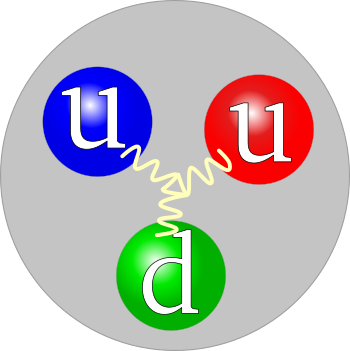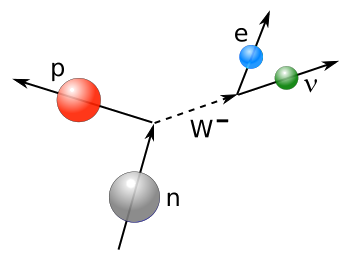Neutron Lifetime Mystery
June 18, 2018
Our
universe is very old. The present estimate of the
age of the universe is 13.8 billion years. For the universe to be this old,
matter must be extremely stable. The
atoms of
chemical elements are composed of
nuclei and their surrounding
electrons. As far as we know, electrons are
eternal, having an estimated
lifetime of greater than 5 x 10
28 years.
Nuclei are composed of
protons and
neutrons. The estimated lifetime of protons is essentially the same as electrons, so they, too, seem to be eternal. As if to confirm the importance of
trinity, we now know that protons are
composite particles formed from three
quarks of two types. These are interestingly named the
up quark and
down quark (see figure).

Quark structure of a proton.
Quarks have a property called color charge, and all three different "colors," red, green, and blue, are present in a proton.
Such a stretch of analogy between the three primary optical colors and a property of quarks hints that physicists have reached a point where analogy between everyday objects and quantum objects has outlived its utility.
Wikimedia Commons image by Jacek Rybak.
The number, three, is an important concept in
Arthur C. Clark's novel,
Rendezvous with Rama, in which the
The Ramans do everything in threes. There are also three types of people in the world, those who believe that the number three is important, those who believe that three is just another number, and those who never considered this question. Most of the world falls into this last category.
Neutrons are also composed of three quarks of different colors, but the neutron has two
down quarks, and one
up quark. For this simple reason, there's a lot of difference between protons and neutrons, the most important of which is that neutrons are not eternal. While neutrons are relatively stable in most nuclei, they do decompse. Neutrons in unstable nuclei, such as the carbon-14 isotope of carbon, decay via a process called beta decay (see figure). The half-life of carbon-14 is about 5,730 years, but a
free neutron decays much faster, also by beta decay, after about 880 seconds by the best present measurements.

Neutron beta decay.
After a lifetime of about 880 seconds, a free neutron (n) produced by spallation or nuclear fission converts into a proton (p) when a down quark transmutes into an up quark with emission of a weak boson (W-).
The weak boson decays into an electron (e) and an antinutrino (ν).
(Created using Inkscape.)
Aside from the obvious question of why a neutron decays at all, what are the consequences of this decay? The decay lifetime of neutrons determined the
ratio of protons to
helium atoms in the universe, and the value of this lifetime is important to
nuclear reactions. That's why there have been many
experiments performed to measure the neutron lifetime. The majority of these measurements are
beam or
bottle. The beam measurements examine neutrons in a
particle beam, while the bottle method traps a number of neutrons in a "
magnetic bottle" to examine their decay. Bottle measurements have given the best lifetime values.
In the bottle method, slow-motion neutrons called
ultracold neutrons that travel just a few
meters per second are trapped using magnetic forces balanced against
gravity. For greatest
accuracy, the neutrons need to be trapped for times much longer than their lifetime. The concept is simple, you just count the remaining neutrons after an interval. As they say,
the devil is in the details, and magnetic bottles are not perfect. Some neutrons will interact with the walls of the magnetic bottle and are lost, leading to a counting error.
A huge team of
physicists has improved the bottle method to give a neutron lifetime value of the highest accuracy to date, 877.7 +0.4/–0.2 seconds.[1-4] The physicists are from the
Los Alamos National Laboratory (Los Alamos, New Mexico),
Indiana University (Bloomington, Indiana),
Triangle Universities Nuclear Laboratory (Durham, North Carolina),
North Carolina State University (Raleigh, North Carolina),
Oak Ridge National Laboratory (Oak Ridge, Tennessee),
Virginia Polytechnic Institute and State University (Blacksburg, Virginia),
West Point Military Academy (West Point, New York), the
Institut Laue-Langevin (Grenoble, France), the
California Institute of Technology (Pasadena, California),
Tennessee Technological University (Cookeville, Tennessee),
DePauw University (Greencastle, Indiana), the
University of Washington (Seattle, Washington), and the
Joint Institute for Nuclear Research (Dubna, Russia).
Beginning in 2005, results of both the beam and bottle methods became so precise that a definite discrepancy between the two neutron lifetime values became apparent. Each measurement method yielded uncertainties at the 0.1% level, below one second, but there was a nine second difference in the values, the beamline lifetime being longer.[2-4] This difference indicates that some undiscovered physics might be involved.[4]
The accuracy of the bottle experiment was enhanced by eliminating certain
errors. First,
polarized ultracold neutrons were contained by
magnetic fields so that they wouldn't interact with the container walls.[1] Next, the magnetic trap was designed to allow a quick removal of neutrons that might leave the trap at longer times, allowing a stable containment of the remaining neutrons for up to three weeks (1.8 million seconds).[2] These improvements, coupled with the use of an
in situ neutron detector, allowed the most precise neutron lifetime measurement to date.[1-2]
Table: Errors for Neutron Lifetime "Bottle" Experiment.[1]
| Effect |
Upper Bound (sec) |
Direction |
| Depolarization |
0.07 |
+ |
| Microphonic Heating |
0.24 |
+ |
| Insufficient Cleaning |
0.07 |
+ |
| Dead Time/Pileup |
0.04 |
± |
| Phase Space Evolution |
0.10 |
± |
| Residual Gas Interactions |
0.03 |
± |
| Background Shifts |
<0.01 |
± |
| Total |
0.28 |
|
Theorists have already proposed a possible reason for the lifetime difference, that neutrons also decay into invisible
dark matter particles instead of protons.[4-5] In that case, neutrons in a bottle would decay faster than those in a beam.[4] Such a decay would also produce a
gamma ray of a specific
energy, so it's a
testable hypothesis.[3] A research team at Los Alamos National Laboratory looked for these gamma rays, but none were detected.[4,6]
There are now efforts to improve the precision of the beam measurement of neutron lifetime. Scientists at the
National Institute of Standards and Technology (NIST) have demonstrated a technique for a fifty-fold improvement in neutron count accuracy over previous measurements.[7] This would bring the final measurement uncertainties for the beam method down to 0.058%, about six
parts in ten thousand.[4] Their goal is to bring the beam method uncertainty in neutron lifetime down to one second.[7]
References:
- R. W. Pattie Jr., N. B. Callahan, C. Cude-Woods, E. R. Adamek, L. J. Broussard, S. M. Clayton, S. A. Currie, E. B. Dees, X. Ding, E. M. Engel, D. E. Fellers, W. Fox, K. P. Hickerson, M. A. Hoffbauer, A. T. Holley, A. Komives, C.-Y. Liu, S. W. T. MacDonald, M. Makela, C. L. Morris, J. D. Ortiz, J. Ramsey, D. J. Salvat, A. Saunders, S. J. Seestrom, E. I. Sharapov, S. K. Sjue, Z. Tang, J. Vanderwerp, B. Vogelaar, P. L. Walstrom, Z. Wang, W. Wei, H. L. Weaver, J. W. Wexler, T. L. Womack, A. R. Young, and B. A. Zeck, "Measurement of the neutron lifetime using a magneto-gravitational trap and in situ detection," Science, vol. 360, no. 6389 (May 11, 2018), pp. 627-632, DOI: 10.1126/science.aan8895. Also available at arXiv.
- Pieter Mumm, "Resolving the neutron lifetime puzzle, Science, vol. 360, no. 6389 (May 11, 2018), pp. 605-606, DOI: 10.1126/science.aat7140.
- Michael Schirber, "Synopsis: Neutron Decay May Hint at Dark Matter," Physics, May 9, 2018.
- Natalie Wolchover, "Neutron Lifetime Puzzle Deepens, but No Dark Matter Seen," Quanta Magazine, February 13, 2018.
- Cynthia Dillon, "UC San Diego Scientists: Is a Dark Particle the 'Dark Horse' of Dark Matter?" University of California San Diego Press Release, March 1, 2018.
- Z. Tang, M. Blatnik, L. J. Broussard, J. H. Choi, S. M. Clayton, C. Cude-Woods, S. Currie, D. E. Fellers, E. M. Fries, P. Geltenbort, F. Gonzalez, T. M . Ito, C.-Y. Liu, S. W. T. MacDonald, M. Makela, C. L. Morris, C. M. O'Shaughnessy, R. W. Pattie Jr., B. Plaster, D. J. Salvat, A. Saunders, Z. Wang, A. R. Young, and B. A. Zeck, Search for the Neutron Decay n -> X+γ where X is a dark matter particle," arXiv, February 5, 2018.
- Neutrons by the Numbers - New counting technique delivers unprecedented accuracy, NIST Press Release, May 21, 2018.
Linked Keywords: Universe; age of the universe; matter; atom; chemical element; atomic nucleus; nuclei; electron; eternity; eternal; exponential decay; mean lifetime; lifetime; proton; neutron; trinity; composite particle; quark; up quark; down quark; color charge; analogy; physicist; quantum mechanics; quantum; Wikimedia Commons; Jacek Rybak; Arthur C. Clark; novel; Rendezvous with Rama; free neutron decays; Inkscape; ratio; helium; nuclear reaction; experiment; particle beam; magnetic mirror; magnetic bottle; ultracold neutron; meters per second; gravitation; gravity; accuracy and precision; the devil is in the details; physicist; Los Alamos National Laboratory (Los Alamos, New Mexico); Indiana University (Bloomington, Indiana); Triangle Universities Nuclear Laboratory (Durham, North Carolina); North Carolina State University (Raleigh, North Carolina); Oak Ridge National Laboratory (Oak Ridge, Tennessee); Virginia Polytechnic Institute and State University (Blacksburg, Virginia); West Point Military Academy (West Point, New York); Institut Laue-Langevin (Grenoble, France); California Institute of Technology (Pasadena, California); Tennessee Technological University (Cookeville, Tennessee); DePauw University (Greencastle, Indiana); University of Washington (Seattle, Washington); Joint Institute for Nuclear Research (Dubna, Russia); measurement uncertainty; error; spin polarization; polarize; magnetic field; neutron detection; neutron detector; theory; theorist; dark matter particle; gamma ray; energy; falsifiability; testable hypothesis; National Institute of Standards and Technology (NIST); parts-per notation; parts in ten thousand.